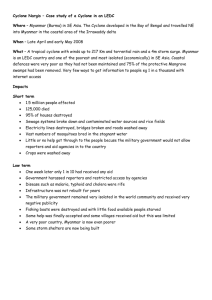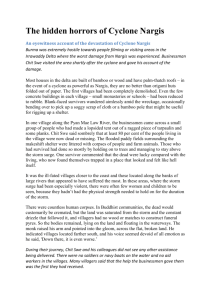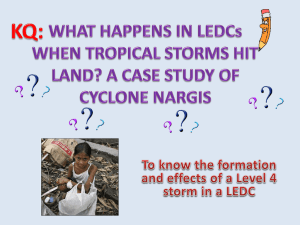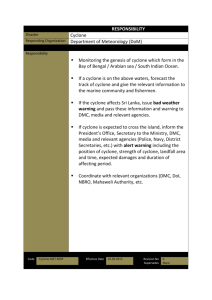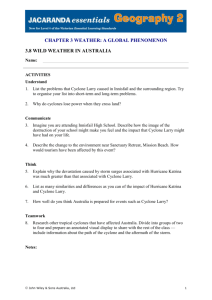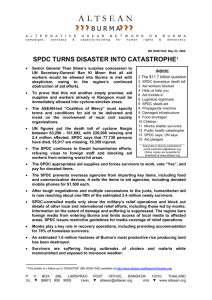Burma`s cyclone children facing wipeout, say charities
advertisement
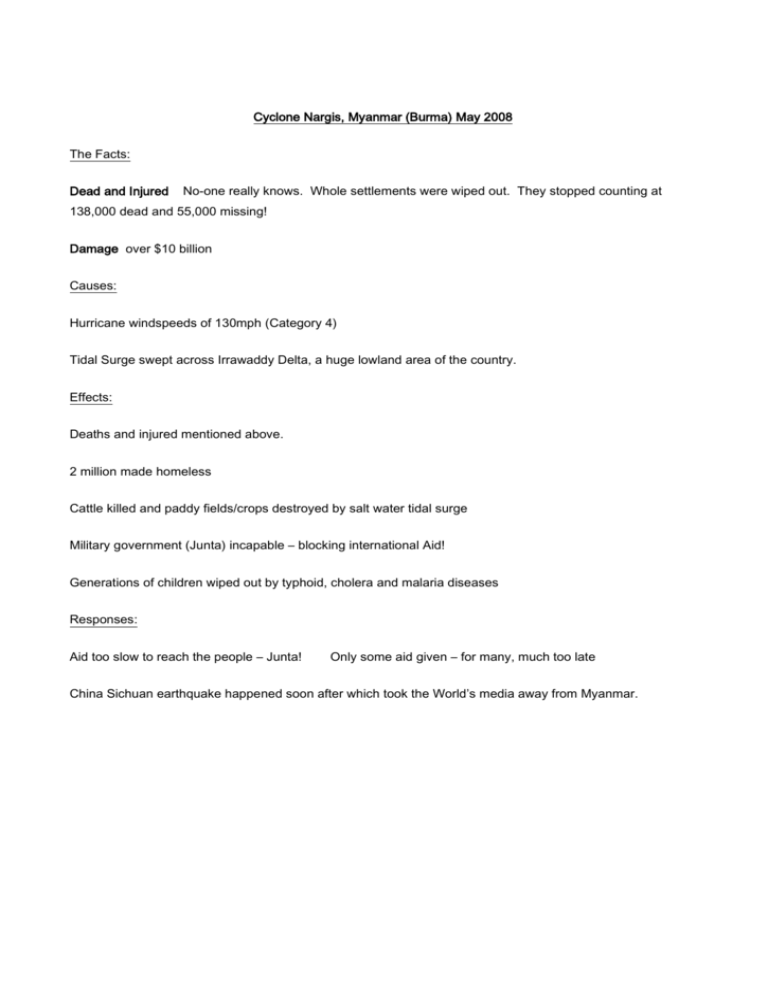
Cyclone Nargis, Myanmar (Burma) May 2008 The Facts: Dead and Injured No-one really knows. Whole settlements were wiped out. They stopped counting at 138,000 dead and 55,000 missing! Damage over $10 billion Causes: Hurricane windspeeds of 130mph (Category 4) Tidal Surge swept across Irrawaddy Delta, a huge lowland area of the country. Effects: Deaths and injured mentioned above. 2 million made homeless Cattle killed and paddy fields/crops destroyed by salt water tidal surge Military government (Junta) incapable – blocking international Aid! Generations of children wiped out by typhoid, cholera and malaria diseases Responses: Aid too slow to reach the people – Junta! Only some aid given – for many, much too late China Sichuan earthquake happened soon after which took the World’s media away from Myanmar. TASK: Underline the most important facts (remember the 3 groups - ‘causes’, ‘effects’, ‘responses’) (The Military ‘Junta’ are the military government) ‘Burma’s cyclone children facing wipeout, say charities’ Harry McKenzie in Rangoon A generation of children could be wiped out if help does not quickly get through to the cyclone-stricken villages of Burma, according to international officials frustrated by the military junta’s obstruction of western aid workers. Charities warned that epidemics of “apocalyptic proportions” could be caused by delays in securing supplies of fresh water and medicines. Latest estimates suggest that up to 116,000 people died when a tidal surge swept across the Irrawaddy River delta from ocean water whipped up by Cyclone Nargis. Of 1.7m who have been left homeless or are in distress, many hundreds of thousands are children who are most vulnerable to waterborne diseases. Reports of dysentery have already surfaced and there are fears of a measles epidemic. Although some aid is reaching Burma, the junta has refused to let it be distributed by foreigners. It insists on using its poorly equipped military to conduct a grossly mismanaged operation. “We are very worried about a ‘second disaster’,” said Greg Beck of the International Rescue Committee. “We’ve had some early indications that cholera is breaking out . . . also dengue fever and malaria. These are treatable and we could contain them very easily if we were able to get access.” Cyclone Nargis was a strong tropical cyclone that caused the worst natural disaster in the recorded history of Burma (officially known as Myanmar). The cyclone made landfall in the country on May 2, 2008, causing catastrophic destruction and at least 146,000 fatalities with thousands more people still missing. However, although the Labutta Township alone was reported to have 80,000 dead, with about 10,000 more deaths in Bogale; and many other deaths were found in other towns and areas, although the Burmese government's official death toll is grossly underreported as they have simply stopped counting the dead to minimize political fallout. It is feared and quite possible that due to lack of relief efforts, a total of a million people already have or will die from this catastrophe. Damage is estimated at over $10 billion (USD), which made it the most damaging cyclone ever recorded in this basin. Nargis is the deadliest named cyclone in the North Indian Ocean Basin, as well as the second deadliest named cyclone of all time, behind Typhoon Nina of 1975. Including unnamed storms like the 1970 Bhola cyclone, Nargis is the 8th deadliest cyclone of all time, but an uncertainty between the deaths caused by Nargis and those caused by other cyclones (like the 1991 Bangladesh cyclone), could put Nargis as 7th deadliest or higher, because the exact death toll is unknown. Nargis was the first tropical cyclone to strike the country since Cyclone Mala made landfall in 2006, which was slightly stronger, but had a significantly lower impact. Relief efforts were slowed for political reasons as Burma's military rulers initially resisted aid. U.S. President George W. Bush said that an angry world should condemn the way Burma's military rulers are handling the aftermath of a catastrophic cyclone. Burma's ruling party finally accepted aid a few days after India's request was accepted. Furthermore hampering the relief effort was the unfortunate fact that only ten days after the cyclone nearby central China was hit by a massive earthquake, known as the Sichuan earthquake which measured 7.9 in magnitude and it alone has taken 69,136 lives and caused 86 billion dollars in damage (US$), making it the costliest disaster in Chinese history and third costliest disaster worldwide. Furthermore, some donated aids were found to be available in the country's black market, and Myanmar's junta warned on May 15th that legal action would be taken against people who trade or hoard international aid. The cyclone name "Nargis" (næɵr-ɡɵs), is an Urdu word meaning daffodil, which has its roots in the Persian Nargess (given name), which has the same meaning. The first named storm of the 2008 North Indian Ocean cyclone season, Nargis developed on April 27 in the central area of Bay of Bengal. Initially it tracked slowly northwestward and, encountering favorable conditions, it quickly strengthened. Dry air weakened the cyclone on April 29, though after beginning a steady eastward motion Nargis rapidly intensified to attain peak winds of at least 165 km/h (105 mph) on May 2 and winds of 215 km/h (135 mph), making it a weak Category 4 cyclone. The cyclone moved ashore in the Ayeyarwady Division of Burma at peak intensity and, after passing near the major city of Yangon (Rangoon), the storm gradually weakened until dissipating near the border of Burma and Thailand. CAUSES: EFFECTS: RESPONSES (or lack of !):
